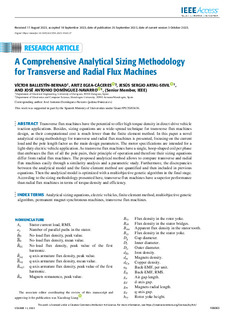
Izenburua
A comprehensive analytical sizing methodology for transverse and radial flux machinesEgilea (beste erakunde batekoa)
Beste instituzio
Universidad de ZaragozaBertsioa
Bertsio argitaratua
Eskubideak
© 2023 The AuthorsSarbidea
Sarbide irekiaArgitaratzailearen bertsioa
https://doi.org/10.1109/ACCESS.2023.3318527Non argitaratua
IEEE Access Vol. 11. Pp. 106063-106082Argitaratzailea
IEEEGako-hitzak
Analytical sizing equations
electric vehicles
finite element method
multiobjective genetic algorithm ... [+]
electric vehicles
finite element method
multiobjective genetic algorithm ... [+]
Analytical sizing equations
electric vehicles
finite element method
multiobjective genetic algorithm
permanent magnet synchronous machines
transverse flux machines [-]
electric vehicles
finite element method
multiobjective genetic algorithm
permanent magnet synchronous machines
transverse flux machines [-]
Laburpena
Transverse flux machines have the potential to offer high torque density in direct-drive vehicle traction applications. Besides, sizing equations are a wide-spread technique for transverse flux machin ... [+]
Transverse flux machines have the potential to offer high torque density in direct-drive vehicle traction applications. Besides, sizing equations are a wide-spread technique for transverse flux machines design, as their computational cost is much lower than the finite element method. In this paper a novel analytical sizing methodology for transverse and radial flux machines is presented, focusing on the current load and the pole length factor as the main design parameters. The motor specifications are intended for a light-duty electric vehicle application. As transverse flux machines have a single, hoop-shaped coil per phase that embraces the flux of all the pole pairs, their principle of operation and therefore their sizing equations differ from radial flux machines. The proposed analytical method allows to compare transverse and radial flux machines easily through a similarity analysis and a parametric study. Furthermore, the discrepancies between the analytical model and the finite element method are quantified and then included in previous equations. Then the analytical model is optimized with a multiobjective genetic algorithm in the final stage. According to the sizing methodology presented here, transverse flux machines have a superior performance than radial flux machines in terms of torque density and efficiency. [-]
Bildumak
Item honek honako baimen-fitxategi hauek dauzka asoziatuta:





















